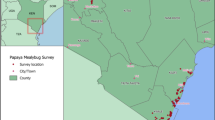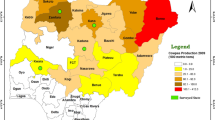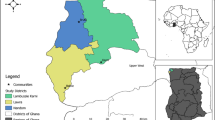Abstract
Survey questionnaires were administered to 50 farmers in three chiefdoms in the Moyamba District of southern Sierra Leone. The study was undertaken to gain insight into the indigenous farming practices for cowpea with emphasis on pest management. This is to serve as a guide in drawing up a research agenda and identifying appropriate measures for the control of cowpea pests. Farm sizes were generally small, usually less than 2 ha of intercropped cowpea. This suggests that the farmers were mostly subsistent and would require low cost inputs to boost production. Vertebrate and insect pests were identified by the farmers as limiting cowpea grain production. Insect pests were considered more serious than vertebrates. Pest control was mostly traditional and involved cultural measures such as weeding of plots, fencing, trapping and scaring of birds. These may be inefficient and labour intensive. Varieties planted by the farmers were mostly land races that have low yield potential and lack some other desirable agronomic character like semi-erectness and bold seeds. Selection criteria in breeding programmes should incorporate farmers’ preferences which include high yields, sweet taste, resistance to pests and diseases, compatibility with the farming systems and acceptable seed appearance that would enhance marketing. The study further revealed that at present cowpea is grown mostly as a secondary crop. Therefore, introduced pest control efforts would have to be cheap, easy to adopt and integrative. These would include:
-
(a)
education on control options hitherto unknown to the farmers
-
(b)
identifying and developing effective strategies that are low cost, labour insensitive, environmentally friendly and compatible with the sociocultural background of the farming community; and
-
(c)
creating awareness on the necessity for the inputs to be readily available and affordable at the local government level.
Résumé
Des questionnaires d’enquête ont été administrées à 50 agriculteurs de trois chefferies du District de Moyamba dans la partie Sud de la Sierra Leone. L’étude a été menée pour avoir un aperçu des pratiques agricoles indigènes sur le niébé, notamment du point de vue lutte dirigée contre les ravageurs. Ceci devra servir de guide en vue d’élaborer un ordre du jour de la recherche et identifier des mesures de lutte appropriées contre les ravageurs du niébé. Les fermes concernées étaient généralement de petite taille, d’habitude moins de 2 hectares de cultures de niébé mélangées à d’autres. Cela suggère que les agriculteurs pratiquaient surtout de l’auto-subsistance et avaient besoin des intrants peu coûteux pour stimuler la production. Les vertébrés et insectes ravageurs ont été reconnus par les agriculteurs comme facteurs limitants de la production des graines de niébé. La lutte contre les ravageurs se faisait de façon traditionelle et avait recours à des mesures culturales telles que sarclage des parcelles, érection des clôtures, piégeage et épouvantails contre les oiseaux. Ces mesures pourraient se révéler inefficaces et coûteuses en main d’oeuvre. Les variétés plantées par l’agriculteur étaient surtout des races locales à faible potentiel de rendement et manquant chez certaines des caractéristiques agronomiques souhaitables telles que la semi-érection et de grosses graines. Les critères de choix dans les programmes de sélection devraient incorporer les préférences de agriculteurs qui incluent de hauts rendements, une douce saveur, la résistance aux ravageurs et aux maladies et des graines d’apparence acceptable qui rehaussent leur valeur marchande. L’étude a de plus révélé que le niébé est maintenant cultivé surtout en tant que culture secondaire. Par conséquent, les effets de lutte contre les ravageurs introduits devraient être bon marché, faciles à adopter et intégratifs et devraient comprendre:
-
(a)
l’éducation sur les options de lutte inconnues jusque-là des agriculteurs
-
(b)
identifier et développer des stratégies efficaces qui soient peu coûteuses, peu dépendance de main d’oeuvre, non nuisibles à l’énvironnement et compatibles avec les habitudes socio-culturelles de la communauté paysanne; et
-
(c)
conscientiser au niveau du gouvernement local sur la nécessité d’avoir des intrants aisément disponibles et à portée de bourse.
Similar content being viewed by others
References
Alghali A. M. (1991) Studies on cowpea farming practices in Nigeria, with emphasis on insect pest control. Trop. Pest Manage. 37, 71–77.
Alghali A. M. (1992a) Insecticide application schedules to reduce grain yield losses by insects of cowpea in Nigeria. Insect Sci. Applic. 13, 725–730.
Alghali A. M. (1992b) On-farm evaluation of control strategies for insect pests in cowpea with emphasis on flower thrips, Megalurothrips sjostedti Trybom (Thysanoptera: Thripidae). Trop. Pest Manage. 38, 420–424.
Ezueh M. I. (1981) Nature and significance of pre-flowering damage by thrips to cowpea. Entomol. Exp. Appl. 29, 305–312.
Ezueh M. I. and Taylor T. A. (1984) Effect of time of intercropping with maize on cowpea susceptibility to three major pests. Tropical Agriculture (Trinidad) 61, 82–86.
Jackai L. E. N. and Daoust R. A. (1986) Insect pests of cowpea. Annu. Rev. Entomol. 31, 98–119.
Kyamanywa S. and Ampofo J. K. O. (1988) Effect of cowpea/maize mixed cropping on the incident light at the cowpea canopy and flower thrips (Thysanoptera: Thripidae) population density. Crop Protection 7, 186–189.
Matteson P. C., Altieri M. A. and Gagne W. C. (1984) Modification of small farmer practices for better pest management. Annu. Rev. Entomol. 29, 383–402.
Mensah G. W. K. (1988) Relative effectiveness of insecticide spray on insect damage and yield of three cowpea cultivars in Swaziland. Insect Sci. Applic. 9, 101–108.
Muleba N. and Ezumah H. C. (1985) Optimising cultural practices for cowpea in Africa. In Cowpea Research, Production and Utilisation (Edited by Singh S. R. and Rachie K. O.), pp. 289–285. John Wiley and Sons, New York.
Rachie K. O. (1985) Introduction. In Cowpea Research, Production and Utilisation (Edited by Singh S. R. and Rachie K. O.), pp. xxi–xxviii. John Wiley and Sons, New York.
Raheja A. K. and Hayes H. M. (1975) Sole crop cowpea production by farmers using improved practices. Trop. Grain Legume Bull. 1, 6.
Singh B. B. and Ntare B. R. (1985) Development of improved cowpea varieties in Africa. In Cowpea Research, Production and Utilisation (Edited by Singh S. R. and Rachie K. O.), pp. 105–116. John Wiley and Sons, New York.
Singh S. R. and Taylor T. A. (1978) Pests of grain legumes and their control in Nigeria. In Pests of Grain Legumes: Ecology and Control (Edited by Singh S. R., van Emden H. and Taylor T. A.), pp. 99–111. Academic Press, London.
Author information
Authors and Affiliations
Rights and permissions
About this article
Cite this article
Alghali, A.M., Pratt, D.E. Utilisation of Farmers’ Practices and Perceptions in the Formulation of Pest Management Strategies for Cowpea Production in Southern Sierra Leone. Int J Trop Insect Sci 16, 103–108 (1995). https://doi.org/10.1017/S1742758400018385
Accepted:
Published:
Issue Date:
DOI: https://doi.org/10.1017/S1742758400018385




